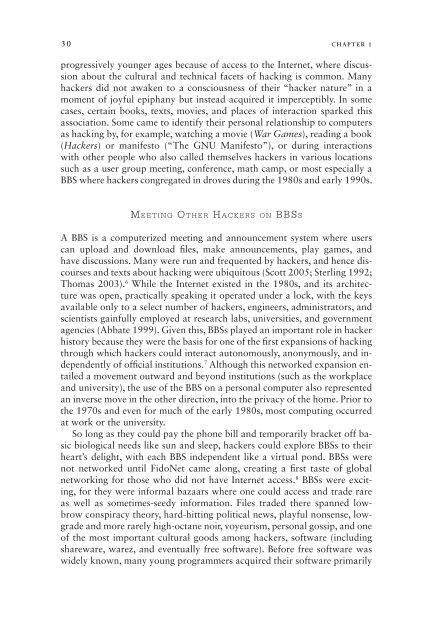V2TXZi
V2TXZi
V2TXZi
You also want an ePaper? Increase the reach of your titles
YUMPU automatically turns print PDFs into web optimized ePapers that Google loves.
30 CHAPTER 1<br />
progressively younger ages because of access to the Internet, where discussion<br />
about the cultural and technical facets of hacking is common. Many<br />
hackers did not awaken to a consciousness of their “hacker nature” in a<br />
moment of joyful epiphany but instead acquired it imperceptibly. In some<br />
cases, certain books, texts, movies, and places of interaction sparked this<br />
association. Some came to identify their personal relationship to computers<br />
as hacking by, for example, watching a movie (War Games), reading a book<br />
(Hackers) or manifesto (“The GNU Manifesto”), or during interactions<br />
with other people who also called themselves hackers in various locations<br />
such as a user group meeting, conference, math camp, or most especially a<br />
BBS where hackers congregated in droves during the 1980s and early 1990s.<br />
M EETING OTHER HACKERS ON BBSS<br />
A BBS is a computerized meeting and announcement system where users<br />
can upload and download � les, make announcements, play games, and<br />
have discussions. Many were run and frequented by hackers, and hence discourses<br />
and texts about hacking were ubiquitous (Scott 2005; Sterling 1992;<br />
Thomas 2003). 6 While the Internet existed in the 1980s, and its architecture<br />
was open, practically speaking it operated under a lock, with the keys<br />
available only to a select number of hackers, engineers, administrators, and<br />
scientists gainfully employed at research labs, universities, and government<br />
agencies (Abbate 1999). Given this, BBSs played an important role in hacker<br />
history because they were the basis for one of the � rst expansions of hacking<br />
through which hackers could interact autonomously, anonymously, and independently<br />
of of� cial institutions. 7 Although this networked expansion entailed<br />
a movement outward and beyond institutions (such as the workplace<br />
and university), the use of the BBS on a personal computer also represented<br />
an inverse move in the other direction, into the privacy of the home. Prior to<br />
the 1970s and even for much of the early 1980s, most computing occurred<br />
at work or the university.<br />
So long as they could pay the phone bill and temporarily bracket off basic<br />
biological needs like sun and sleep, hackers could explore BBSs to their<br />
heart’s delight, with each BBS independent like a virtual pond. BBSs were<br />
not networked until FidoNet came along, creating a � rst taste of global<br />
networking for those who did not have Internet access. 8 BBSs were exciting,<br />
for they were informal bazaars where one could access and trade rare<br />
as well as sometimes- seedy information. Files traded there spanned lowbrow<br />
conspiracy theory, hard- hitting political news, playful nonsense, low-<br />
grade and more rarely high- octane noir, voyeurism, personal gossip, and one<br />
of the most important cultural goods among hackers, software (including<br />
shareware, warez, and eventually free software). Before free software was<br />
widely known, many young programmers acquired their software primarily


